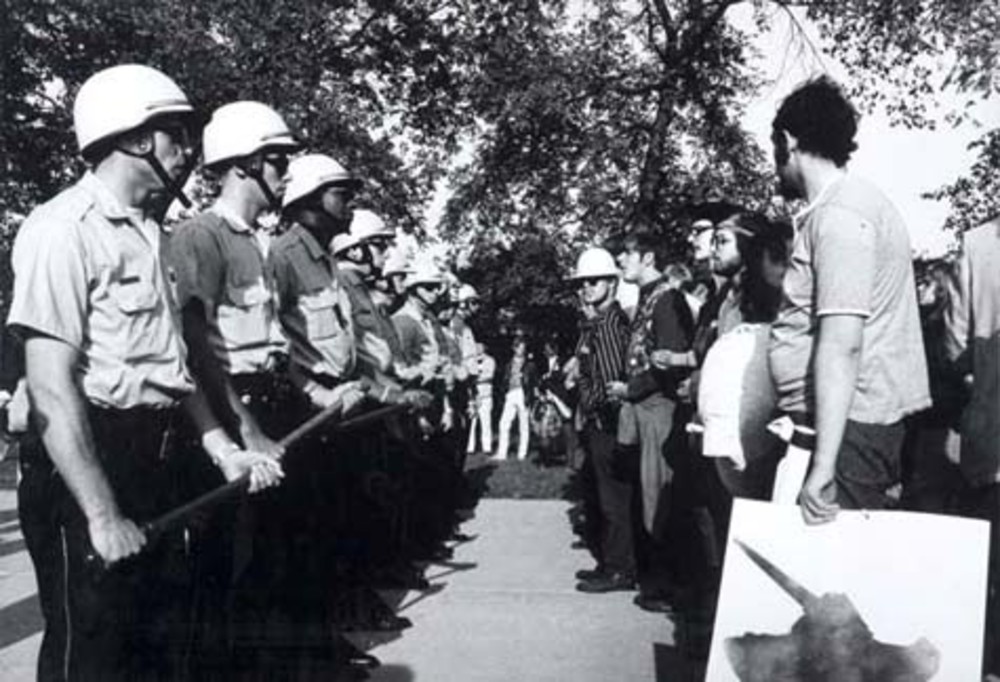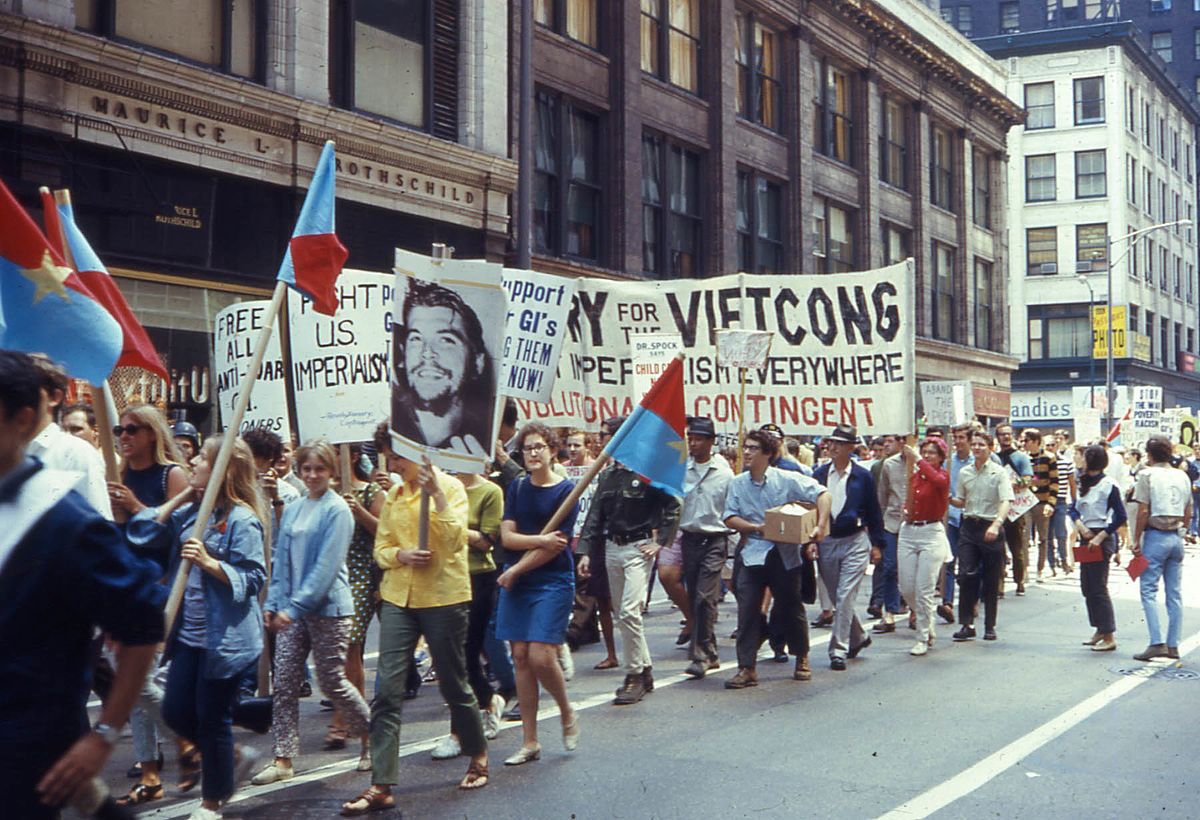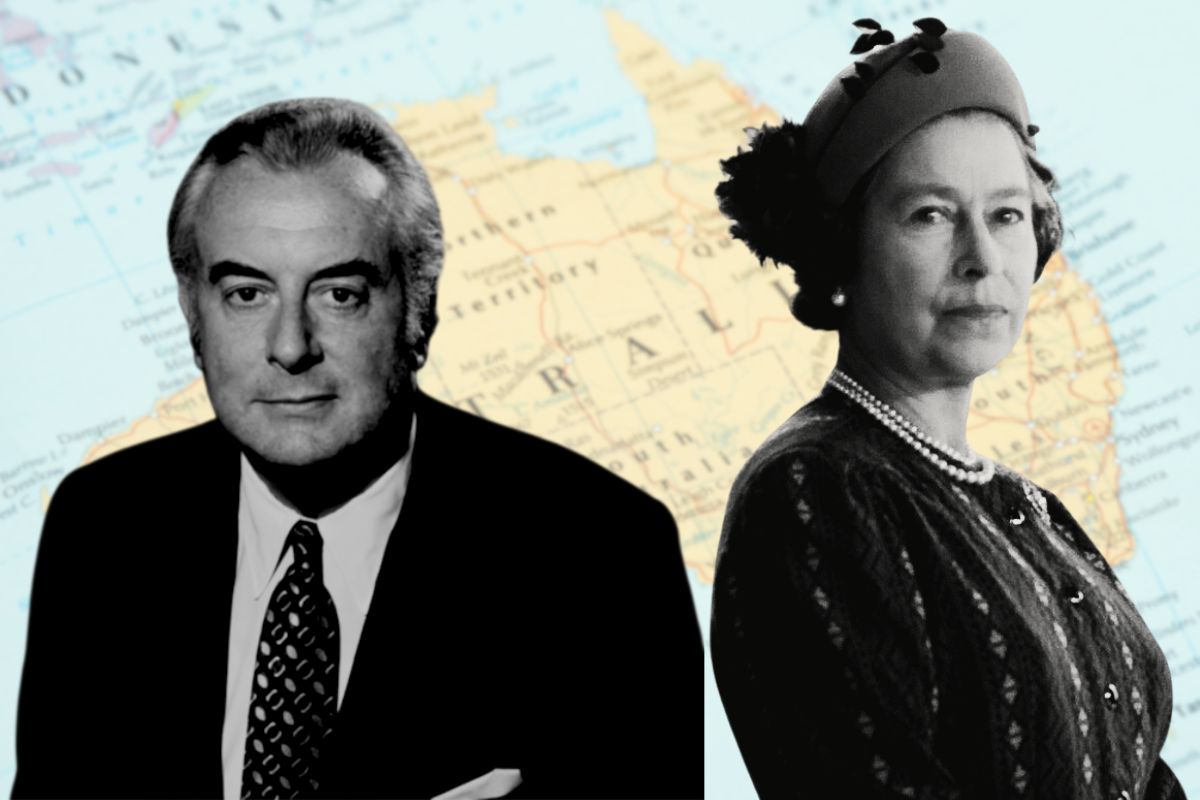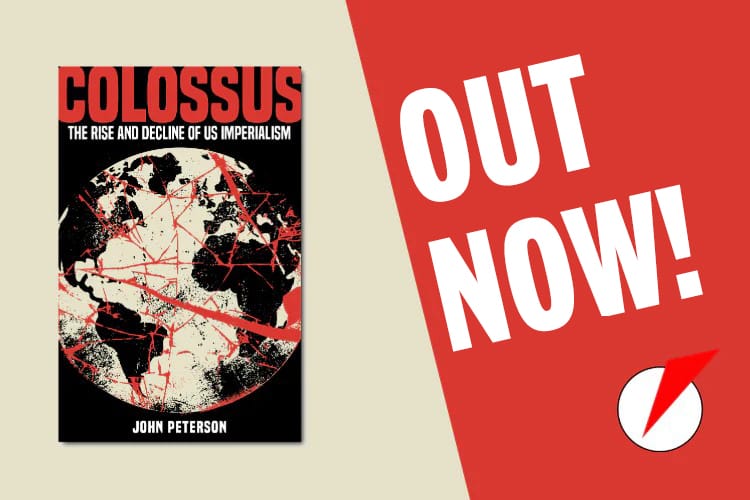The violent events that took place outside the Democratic National Convention in Chicago 50 years ago, between 26–29 August 1968, serve as a defining point for millions of Americans.
After August 1968, many thousands of US students and youth drew the necessary conclusion that the system could not be reformed – something black Americans in the ghettos already understood from their own experiences – and began looking beyond the status quo and the Democratic Party for solutions.
Chicago was the point where many could clearly see that the repressive force of the state was being used against all those seeking justice and an end to imperialist war, poverty, and exploitation.
Explosive conditions
There was already a sense of foreboding in the build up to the Convention. After the killing of Martin Luther King earlier in 1968, black ghettos across America had erupted in protest and riot. It was rightly called a black insurrection.
The response in Chicago from the Mayor, Hon. Richard J. Daley, was all too clear: “shoot-to-kill arsonists and shoot-to-maim looters”. A marker had been laid.
Daley was one of the last of the old-style corrupt city bosses. He ruled everything and was firmly in the pocket of big business. There had been opposition to having the Convention in Chicago, and many felt that there would be trouble.
By early summer, plans were being laid by all those opposed to the Vietnam war to use the Convention as a rallying point; a chance to be seen and heard by the whole of America.
Opposition to the war would be the central theme – but it was also intended to draw in those fighting against racism, urban poverty and all the over problems that gave lie to the so-called American dream.
A target of 100,000 protestors descending on Chicago for the Convention week was set. Such potentially huge numbers filled the Chicago establishment with dread and Daley was having none of it.
What terrified the likes of Daley was that the movement would go beyond the layer of long-haired hippies and other student types that typically made up the majority on such protests.
The establishment feared that the demonstrations could ignite the black ghettos, where regular police oppression remained in place and was a source of ongoing anger. Chicago would go up first, then Washington, New York, Boston and beyond. This is what Daley and co. were determined to prevent happening.
The un-Democratic Party
 The organisation for the protest drew in all manner of groups: the Yippies (Youth International Party); the so-called New Left; the Students for a Democratic Society (SDS); and an assortment of other campaign groups. These were all lined up behind the umbrella grouping of the Mobilisation to End the War in Vietnam (Mobe), which took the lead in planning the event.
The organisation for the protest drew in all manner of groups: the Yippies (Youth International Party); the so-called New Left; the Students for a Democratic Society (SDS); and an assortment of other campaign groups. These were all lined up behind the umbrella grouping of the Mobilisation to End the War in Vietnam (Mobe), which took the lead in planning the event.
The work to get appropriate permits begun in April. Those involved did not realise, however, that Daley had already made it clear to his officials that they should stall and that no permits were ever going to be granted.
As August grew nearer, it was also becoming clear that the Convention itself was not going to be plain sailing for the party establishment.
After Lyndon B. Johnson (LBJ) announced that he would not be standing for a second full term as President, worn down by opposition to the war, the Vice-President Hubert Humphrey became the front-runner for the candidacy.
Humphrey’s main opponent, Bobby Kennedy, had been assassinated in June. In any case, with most delegates being selected by the party bosses (primaries were not common yet at this time), Humphrey was already assured of being on the ticket as the Democratic Party candidate.
Those opposed to the war and the social retreats of LBJ, however, had begun to coalesce around the option of Senator Eugene McCarthy. All hopes rested with him as the so-called peace candidate.
Anyone who attended the Convention would have quickly seen how hopeless the prospect of a McCarthy victory was. The rigging of the delegates and the endless organisational manoeuvres (repeated nearly 50 years later to hinder Bernie Sanders) all showed just how democratic the Democratic Party really was. It was evident to all that the Democrats were – and still are – a party by and for big business and the rich elite.
Despite himself, McCarthy would be seen as a focal point for the growing division within the party. But he was also a symbol of why that party would not and could not change anything fundamental.
State machinery
 Whilst Daley’s officials smiled and stalled, the lawmakers were working overtime over the summer. First they passed a city ordinance stopping anyone from sleeping overnight in the city parks and grounds without permission – a popular pastime in summer for boy scouts and the like – so as to discourage those intending to come to the protest and camp.
Whilst Daley’s officials smiled and stalled, the lawmakers were working overtime over the summer. First they passed a city ordinance stopping anyone from sleeping overnight in the city parks and grounds without permission – a popular pastime in summer for boy scouts and the like – so as to discourage those intending to come to the protest and camp.
Laws against disorderly conduct and trespass were also passed, and it was made clear that you could now be arrested for doing “any unreasonable or offensive act, gesture, utterance or display which…creates a clear and present danger of a breach of the peace.” In effect, you could be arrested at will.
For good measure, a federal law was also passed declaring that the conspiracy to cause a riot was now a federal crime.
Daley also set about using the mass media to whip up fears about the “trouble” that was heading Chicago’s way with “the Yippies and the crazies”.
A university study from 2001 (Blood, Sweat and Gas: Print Media and the 1968 Democratic National Convention by Sarah Love, University of Montana) would later confirm that pretty much all the national and local titles both before and during the Convention were hostile to the protestors and faithfully reported all the wild statements and lies made by Daley and others.
Daley even managed to spread the totally fictional warning that the threat of an assassination attempt existed at the Convention, hence the need for special measures. The governor of Illinois warned of “tumult, riot and mob disorder.”
It was even reported that the Soldier’s Field stadium would be used as a mass detention and trial centre by the authorities, given the number of expected arrests.
By early August, Daley was discussing with the Governor of Illinois about using the National Guard to back up the police. However, he was warned that the National Guard might be too sympathetic to the demands of the anti-war protestors, having been drawn from those who wished to avoid being sent to Vietnam. Daley therefore turned instead to whipping up the local police, complaining that in previous protests they had been too keen to use “minimal force”.
When protestors did try to march into the black ghetto on the Thursday of the Convention they were met by the Illinois National Guard, armed to the teeth and ready to shoot. As feared by Daley and others, black people who saw the protests visibly demonstrated their support, showing that they were ready to link up against the common enemy of a brutal and oppressive system.
It soon became clear that Daley and the local cops were going to crack down hard on the protests by any means necessary and the original attendance estimates fell sharply. In fact, it was feared early on that nobody at all would risk turning up, given all the blatant threats being spread around by the establishment.
Nevertheless, thousands were determined to come, and now they knew what to expect.
Mayhem
 In an article of this length, it is impossible to describe or even list all the various conflicts, stand-offs, and pitched battles that would occur between the Sunday and Friday of the Convention week.
In an article of this length, it is impossible to describe or even list all the various conflicts, stand-offs, and pitched battles that would occur between the Sunday and Friday of the Convention week.
Inside the Convention hall, the party establishment were trying to keep a lid on the whole thing, even as delegates and others tried to raise from the floor the issue of the war and the violence happening outside. At one point, the violence even spread inside the Convention, with cops manhandling veteran reporter Dan Rather.
Clearly it could not be a case of business as usual, with delegates trying to clear the effects of drifting tear gas from their eyes.
Outside the hall, the scene was one was of sheer mayhem. Day after day, night after night, protestors were met with brutal force from the Chicago cops.
The names given by history to the various incidents that occurred accurately sum up the situation: the battle at the Bandshell; the battle at Michigan and Balbo corner, etc. These were battles – and brutal battles at that. Except that in these battles, one side was armed and the other not.
Attempts to reach the Convention hall by protestors were beaten back. Mass arrests were the order of the day.
It would later be noted that people turning on the TV news reports often initially assumed they were watching bloody footage from Czechoslovakia, where Russian tanks had just rolled in to crush the Prague Spring.
What made it worse was that most of those present, including the organisers, were clueless about how to resist this. Facing armed cops with Buddhist chanting and hippy talk about peace and love was never going to cut it. Even the agent provocateurs sent in to stir up trouble were not initially challenged.
Serious training to steward and protect protestors was only done in a limited way late in the day. This was a mistake that would not be made again in future protest marches and rallies in the years to come. For example, anti-war protestors would make a point of carefully positioning their toughest Vietnam war vets so as to make the police think twice about any provocations.
On the Friday, the police showed how confident they were in crushing any opposition. The McCarthy campaign headquarters on the 15th floor of the Hilton Hotel were raided at 5.00am. Campaign workers, mainly young kids, were dragged out of their rooms and most got a beating for their trouble.
In his book No one was killed (1969), journalist John Schultz writes about how politicised many of those involved in this violent attack became – they were being pushed to the left by events.
The were not the only ones. Schultz writes of a Chicago newsman saying to other reporters: “This whole thing has moved me so far left I can see the back of my head.”
Scapegoats
 In the aftermath of that week of bloodshed there were a number of official reviews into what had happened. Most blamed the police, referring to it as a police riot. Yet the police rank-and-file representatives were quick to make clear that they had been acting under strict orders and had not lost control.
In the aftermath of that week of bloodshed there were a number of official reviews into what had happened. Most blamed the police, referring to it as a police riot. Yet the police rank-and-file representatives were quick to make clear that they had been acting under strict orders and had not lost control.
Indeed, the fact that no one actually died, despite the huge numbers injured, shows that the cops understood the limits of what they could do and followed them.
It is worth noting that during the riots in the black community in Miami earlier that month, during the Republican Convention, three people had been killed and many more injured. This was as a result of the governor of Florida making it clear that insurrection would be dealt with using “whatever force was necessary”.
So angry were many Chicago cops about how they were being set up that the Confederation of Patrolmen (C.O.P) reported a sharp rise in membership in the months that followed. Later C.O.P. would issue a statement saying that officers should not trust anything that wasn’t in writing, informing their members that they should make sure they know who is giving any orders, keep full notes of such orders, and take care when following them. They, at least, knew where the real blame lay.
Democrat defeat
A number of myths have sprung up about the Chicago events. The main one is that it cost the Democrats the election in November.
The Republicans had already chosen Richard Nixon as their candidate, feeding off the growing fears of the middle classes about how US society was falling apart. All the Democrats had to offer in response was Hubert Humphrey.
Many Americans saw this as no choice at all and simply did not vote. With a number of the white racist votes in the South especially being siphoned off by the Wallace split-off campaign, Nixon was always going to be favourite to win the election.
The damage had already been done by the LBJ years; the 1968 election was only the first of many elections where people simply felt they had no real choice: workers correctly saw it as a fight between two wings of one capitalist class, as author Gore Vidal would later put it.
What Chicago did do was politicise ordinary people as never before. On the streets and on the TV every night, people were seeing the real face of America. A process that was already underway in the black ghettos of America now spread to the colleges and beyond.
Class conclusions
 The Black Panthers saw a sharp rise in membership, particularly from the youth. As an organisation it was moving left, putting increased effort and emphasis on the need to study socialist ideas.
The Black Panthers saw a sharp rise in membership, particularly from the youth. As an organisation it was moving left, putting increased effort and emphasis on the need to study socialist ideas.
The Panthers were raising issues from a class perspective, attacking the capitalist system directly. Indeed, a number had managed to get past the police cordons to attend some of the protests, noting that “lines of allegiance other than colour were nearly surfacing in American life” (Schultz 1969).
Thousands of white students and youth also started to look for revolutionary alternatives. Hopes of using the Democratic Party and the system to change things were abandoned by many. Within a year of Chicago, the SDS had broken apart and new organisations came to the fore.
The growing mood of reaction within the state only fuelled this. Nixon in office accelerated the internal assault on Americans’ rights. This started with the attack on the “leaders” of the Chicago protests. Although the initial mood in Washington was to take no action, Nixon pushed for the full force of the law to be applied – to teach these hippy longhairs a lesson.
Using an obscure federal law that made it a crime to cross state lines for the purpose of “inflaming” protest, eight key figures were arrested and charged. The trial of the Chicago Eight would go down in history as one of the most blatant travesties of justice in American legal history. But that is a story for another time.
What did quickly become clear was that Nixon and his co-thinkers were going to smash any opposition – real or imaginary – with any and all resources to hand. No more hiding behind the mask of the ‘land of the free’.
It has been said that whilst many Americans in 1966 saw the government and the state as representing and working for them, by 1976 the mood was very different, almost paranoiac.
The next ten years after 1968 would see not only the Chicago Eight trial but also the Pentagon Papers, Kent State, the murdering of Black Panther leaders, US involvement in the Chilean coup, as well as (of course) the Watergate scandal, to name but a few.
Limits on the left
 In this context, it is one of the great tragedies of US class history that there was no Marxist organisation in America able to provide a clear programme and method to all those workers and youth looking for a way forward.
In this context, it is one of the great tragedies of US class history that there was no Marxist organisation in America able to provide a clear programme and method to all those workers and youth looking for a way forward.
Although the white working class was not really involved in the protests of Chicago 1968 (although, as it happened the Convention hall electricians were already on strike over an employment dispute), they were increasingly politicised both by the war and by the economic downturn of the 1970s.
Black workers – who were already taking the brunt of all this, on top of the racism they saw every day – were ahead of their white co-workers in this respect. The Black Panthers were discussing Marxism and revolution. So too now were students in the universities and colleges.
Yet, in the absence of a genuine Marxist organisation, these radicalised layers had nowhere to turn but to the various groups and ideas that have tended to mark the trendy left in the US. These ranged from variations of Stalinism through to anarchism and terrorism (see, for example. the Weathermen). Most of these were infiltrated by government agents, happy to find any suitable excuse for ramping up the repressive apparatus of the state.
Even those groups which called themselves Marxist (or even Trotskyist, for that matter) had abandoned any clear Marxist ideas long ago in favour of a whole army of various ‘isms’.
Under the weight of all these half-baked ideas – nearly all of which alienated any workers who might have somehow come across them – the radical mood started to dissipate by the early-to-mid ‘70s, especially after the war ended and Nixon was forced to depart from office in disgrace.
Most of the more visible radical figures of the Sixties wandered off and got good jobs in politics or law.
Struggle against the system
 Fifty years later, with Trump in office, the events of 1968 have taken on an acute relevance.
Fifty years later, with Trump in office, the events of 1968 have taken on an acute relevance.
The system is just as rotten, just as corrupt, just as brutal. Things have gotten steadily worse, not better. Hundreds of thousands across America have already protested over the shootings of black youth. The potential for a struggle against the system involving millions in there for all to see.
The task that lies ahead is to build the forces of genuine Marxism in the USA, in order to provide a way forward for the increasing numbers who are seeing the need to change society. The comrades of the Workers International League – the US section of the International Marxist Tendency – are committed to that task.






